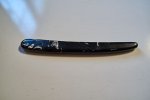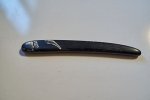pcm
New member
Hi,
One of the razors that I have, a Filarmonica, has a broken scale that I'd like to give a go at trying to create a replacement. What material can/should I use, and where would I buy it from?
I want to take it on as a project, as although it is not a unique or special razor by any means, it has some history for me. I bought it at an antique store for like $20, and it had a horrible, huge, nick (or maybe crater ) on the edge, and was rusty.
) on the edge, and was rusty.
Through this forum, many years ago, I worked on resurrecting the blade and getting to a very usable/shaveable edge. Not my best shaver, but it was a competent shaver. I was very proud, as it was the first time I had a "challenging" blade to deal with (most were new or used blades that had normal wear - only had one Saunders wedge that was a challenge, but not like this).
At the time, there was a crack, right at the pin on the blade side, so I knew it was at risk for failure. It finally broke, so I set it aside for a while (not enough oil on it, so it has some surface rust on the spine that I'll need to address).
I've never taken on this type of thing, but I'm pretty handy, retired now, and willing to give it a go (no loss/no foul, if it doesn't work out). I'm hoping to just put some plain scales on it (nothing fancy), and use the existing ones as a template. I'd be curious as to how to remove the pins and reinstall (or where to get replacements).
Any thoughts? Thanks in advance!
One of the razors that I have, a Filarmonica, has a broken scale that I'd like to give a go at trying to create a replacement. What material can/should I use, and where would I buy it from?
I want to take it on as a project, as although it is not a unique or special razor by any means, it has some history for me. I bought it at an antique store for like $20, and it had a horrible, huge, nick (or maybe crater
Through this forum, many years ago, I worked on resurrecting the blade and getting to a very usable/shaveable edge. Not my best shaver, but it was a competent shaver. I was very proud, as it was the first time I had a "challenging" blade to deal with (most were new or used blades that had normal wear - only had one Saunders wedge that was a challenge, but not like this).
At the time, there was a crack, right at the pin on the blade side, so I knew it was at risk for failure. It finally broke, so I set it aside for a while (not enough oil on it, so it has some surface rust on the spine that I'll need to address).
I've never taken on this type of thing, but I'm pretty handy, retired now, and willing to give it a go (no loss/no foul, if it doesn't work out). I'm hoping to just put some plain scales on it (nothing fancy), and use the existing ones as a template. I'd be curious as to how to remove the pins and reinstall (or where to get replacements).
Any thoughts? Thanks in advance!


